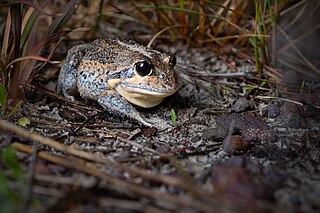
Limnodynastes dumerilii is a frog species from the family Limnodynastidae. The informal names for the species and its subspecies include eastern or southern banjo frog, and bull frog. The frog is also called the pobblebonk after its distinctive "bonk" call, which is likened to a banjo string being plucked. There are five subspecies of L. dumerilii, each with different skin coloration. The species is native to eastern Australia. There has been one occurrence in New Zealand, when tadpoles of the species were found in 1999 and destroyed.

Crinia is a genus of frog, native to Australia, and part of the family Myobatrachidae. It consists of small frogs, which are distributed throughout most of Australia, excluding the central arid regions. Many of the species within this genus are non-distinguishable through physical characteristics, and can only be distinguished by their calls.

The common eastern froglet is a very common, Australian ground-dwelling frog, of the family Myobatrachidae.

The Tasmanian froglet is a species of ground-dwelling frog that occurs only in Tasmania, Australia.

The wallum froglet is a species of ground-dwelling frog native to the east coast of Australia, from southeast Queensland to Kurnell, NSW. It is strongly associated with Wallum swampland.

The dusky toadlet is a species of Australian ground-dwelling frog that inhabits coastal areas from just north of Sydney, New South Wales to mid-northern Queensland.
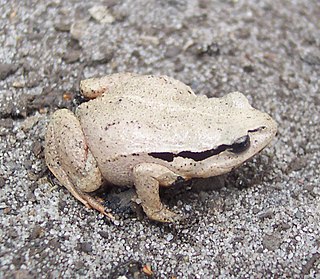
Haswell's frog is a small ground frog found around coastal swamps in eastern Australia from around Port Macquarie, New South Wales to the Mornington Peninsula in Victoria. It is the only member of the genus Paracrinia.

The tusked frog is a species of ground-dwelling frog native to eastern Australia from Eungella National Park, Queensland south to Ourimbah, New South Wales. It is the only species in the genus Adelotus - adelotus meaning "unseen" and brevis meaning "short".

The dainty green tree frog, also known as the graceful tree frog, is a species of tree frog in the subfamily Pelodryadinae. It is native to eastern Queensland, and north-eastern New South Wales, Australia and ranges from northern Cape York in Queensland to Gosford in New South Wales, with a small and most likely introduced population in Hornsby Heights in Sydney. It is one of two faunal emblems of the City of Brisbane.

The striped rocket frog, or in its native range known as the rocket frog, is a species of frog that occurs mostly in coastal areas from northern Western Australia to around Gosford in New South Wales at its southernmost point, with a disjunct population occurring further south at the Sydney suburb of Avalon. It also inhabits the southern lowlands and south east peninsula of Papua New Guinea.
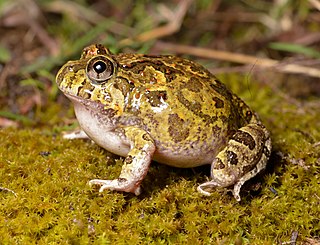
The ornate burrowing frog is a species of ground frog native to Australia. It was moved to the genus Opisthodon in 2006, following a major revision of amphibians, and is now classified in the genus Platyplectrum.

The crucifix toad, holy cross frog or Catholic frog is a species of frog in the family Limnodynastidae. It is a fossorial frog. It is one of the few Australian frogs to display aposematism. It is native to western New South Wales and south-western Queensland.

The Sudell's frog, painted burrowing frog, trilling frog or desert trilling frog is a species of burrowing frog common to a large part of southeastern Australia. It is found on and west of the Great Dividing Range of New South Wales to western Victoria and southern Queensland, as well as far eastern South Australia, and southern regions of the Northern Territory.
The streambank froglet or Flinders Ranges froglet is a small, locally common, Australian ground-dwelling frog, of the family Myobatrachidae.
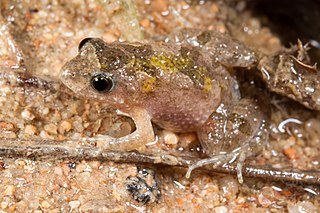
The desert froglet, chirping froglet, or sparrow froglet is a species of frog in the family Myobatrachidae, endemic to Australia. Desert froglets occur mainly in dry or moist savanna habitats, principally from the mid-western border of Northern Territory, south-east into western Queensland and New South Wales and the north-east corner of South Australia. They can also be found along the Queensland coast where it has been recorded between Townsville and Cooktown, and as far south as Hervey Bay.

The quacking frog, also known as the red-thighed froglet due to its legs tending to be bright red, is a species of frog from the Myobatrachidae family and is in a clad with five other species. The frog is well known for the sound it produces which resembles a quack. It has up to 11 notes and can change the notes in their call. It has larger testes compared to other frogs within the genus and has started to be used in experiments. This frog is found in southwest Australia. It is found in ponds and pools and other moisture filled areas. These frogs engage in polyandry and can result in multiple paternity of its offspring. Additionally, the tadpoles of this species can change the rate they metamorphosize depending on the conditions. The males tend to have larger arm girth and can adopt different mating strategies depending on size. The mating strategy is dependent on male density. The frogs also vary in terms of colour and texture of its skin. The tadpoles are generally golden with transparent tails.
The rattling froglet , also called the clicking froglet or Glauert's froglet, is a frog in the Myobatrachidae family that is endemic to Australia.

The moss froglet is a species of frog in the family Myobatrachidae. It is endemic to southern Tasmania.
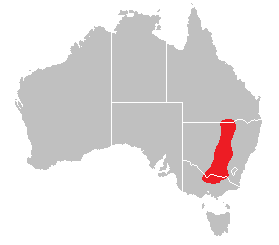
Sloane's froglet is a species of frog in the family Myobatrachidae. It is endemic to Australia. Its natural habitats are subtropical or tropical seasonally wet or flooded lowland grassland and intermittent freshwater marshes in and around the floodplains of the Murray-Darling Basin


















